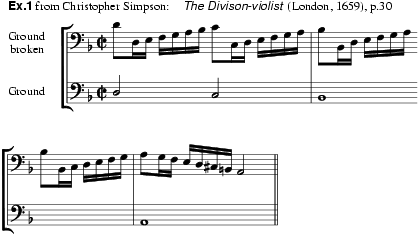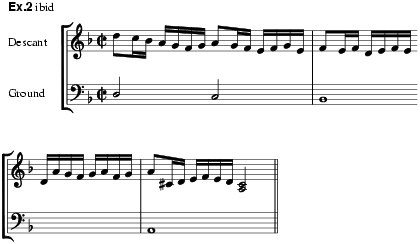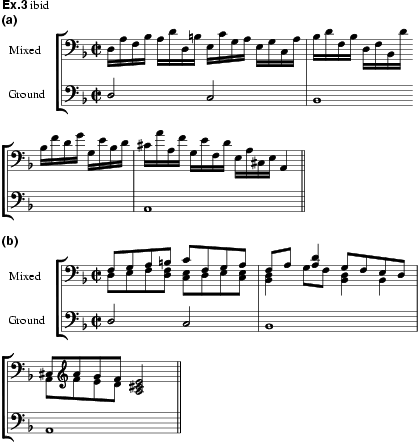
A term used in England during the 17th century for a technique of improvised variation in which the notes of a cantus firmus, or Ground, are divided into shorter ones, usually not of the same pitch, and chosen with regard to clearly delineated rules of musical composition. Division playing, especially on the Division viol, achieved a high degree of excellence during the second half of the 17th century. It may be viewed as part of the long tradition in Western music of variation and embellishment practices both as spontaneously performed improvisations and as formal compositions. Earlier terms referring to similar practices in the 16th and early 17th centuries (particulary in Italy, England and Spain) are Diminution (It. diminuire), diferencia (Sp.) and breaking (as in ‘breaking bass’): these are fully discussed in Improvisation, §II and Variations, §6. In England this tradition was practised by singers as well as by players of keyboard, wind and string instruments. During this period these instruments relied on pre-existing vocal or dance music as a basis for variations, but by the time Simpson codified the principles of division playing, instrumental divisions were evolving idioms of their own and were changing from an adornment of what was divided into the actual musical substance itself.
The best source of information concerning English division playing is Christopher Simpson’s The Division-Violist; or An Introduction to the Playing upon a Ground (1659, 2/1667 [dated 1665]/R as Chelys: minuritionem artificio exornata/The Division-Viol, or, The Art of Playing ‘Ex tempore’ upon a Ground). According to Simpson, division can be separated into three categories: breaking the ground, in which the ground bass itself is ornamented (ex.1); descant, which consists of dividing imagined melodies above the ground (ex.2); and mixed division, which is a mixture of the first two and ‘presents unto our Eares, the Sounds of two, or more Parts moving together’. The latter may be performed in two ways, ‘either in Single-Notes, by hitting first upon one Part, and then upon Another [ex.3a]; or in Double-Notes, by touching Two, or More Strings at once with the Bow [ex.3b]’.



Roger L'Estrange, in his preface to the second edition of The Division-Viol, cites Simpson's instructions that descant and ‘diminutions upon a ground’ are useful ‘in all sorts of Musick whatsoever’. Mixed division is not mentioned in this context, however, since it produces a texture particularly suited to the technique of the viol.
During the first half of the 17th century in England divisions were played on the consort bass and especially the Lyra viol. Tobias Hume included a ground in the form of a galliard with divisions for bass viol in The First Part of Ayres (1605), as well as an early reference to division (but not to division viol); examples for lyra viol may be found in William Corkine's Second Booke of Ayres (1612), such as a set of variations on the song Walsingham. By about 1650, however, a special instrument, mid-way in size between the consort bass and the lyra viol, was developed specially for division playing. The Division viol, described both by Simpson, and by John Playford in the 1664 edition of A Brief Introduction to the Skill of Music, was heir to both the linear style of the continental Viola bastarda and the harmonic style of the English lyra viol.
The art of division playing was primarily an extemporaneous one. According to Simpson, the ability to play thus was
a guift of Nature … He, that hath it not, in so high a Measure, as to Play Ex tempore to a Ground; may, Notwithstanding, give both himself, and hearers, sufficient satisfaction, in Playing such Divisions, as Himself, or Others, have made for that purpose.
Simpson recommended as worthy of study and imitation composed divisions for one viol to a ground by Henry Butler and Daniel Norcombe. (Works attributed to them are included in US-NYp Drexel 3551, which is bound with a copy of Simpson's first edition.) His own collection, modestly titled ‘Divisions for the practice of Learners’, makes up the final section of his treatise and contains many beautiful compositions. Another didactic treatise on viol playing, including a noteworthy collection of compositions exemplifying the improvisational practices of 16th-century Italy, is Diego Ortiz's Trattado de glosas (Rome, 1553). Mentioning both treble and bass instruments, Simpson discussed compositions for two and three dividing viols and praised such works by ‘the ever Famous, and most Excellent Composer, in all Sorts of Modern Musick, Mr. John Jenkins'. A number of dances by Jenkins with fine simultaneous treble and bass divisions for the repeats of each strain are extant (in GB-Ob Mus. Sch.C.88; ex.4). An interesting point concerning divisions for more than two dividing instruments is that they
are not usually made upon Grounds; but rather Composed in the way of Fancy: beginning with some Fuge; then falling into Points of Division; answering One Another; sometimes Two answering One, and sometimes, All joyning Together in Division; But commonly, Ending in Grave, and Harmonious Musick.
There are four-part fantasias by John Jenkins that fit this description (MB, xxvi, nos.33a, 34a).

Understanding the structural aspects of composed divisions is not the same as understanding how to extemporize a musical performance, and Simpson provided valuable information on this:
A Ground, Subject, or Basse, (call it which you please,) is prickt down in two severall Papers: One, for him who is to Play the Ground (upon an Organ, Harpsecord, or what other Instrument may be apt for that Purpose;) the Other, for him who Playes upon the Viol: who, having the said Ground before his Eye; (as his Theme, or Subject;) Playes such Variety of Descant, and Division, thereupon; as his Skill, and present Invention, do then suggest unto him.
These instructions are elaborated on in language addressed directly to the prospective performer:
I would have you First Play over, the Ground it self; for these Reasons. (1) That Others may heare what Notes you divide upon. (2) That your self may be better possessed of the Ayre of the Ground, in case you know it not before. (3) That he who Playes the Ground unto you may better perceive your Time, or Measure.
Simpson's description of how divisions can be extemporized by two viols over a ground is most informative. The actual number of repetitions of the ground is not established. In two places the performers are instructed to carry out particular procedures ‘so long as they think fit’, or ‘so long as they please’. The performance is separated roughly into three sections by the keyboard player who at two places ‘(if he have Ability of Hand,) may, upon a Signe given him, put in his Strain of Division’. The relationship of the viols to each other begins as accompaniment and solo – one playing the ground bass while the other improvises descant division. These roles are exchanged at each repetition. After the first strain of keyboard divisions, however, the viols introduce two other more complicated procedures. One is the simultaneous extemporizing of descant and ground-bass divisions; specific instructions are given according to which the viols may ‘move a whole Strain together, in Extemporary Division, without any remarkable clashing in 5ths or 8ths’. The second is strikingly similar to a procedure known as ‘fours’ in jazz improvisation where each improviser relinquishes the solo to another after every four bars; one violist calls out the word ‘breve’, ‘semibreve’ or ‘minim’, signifying his intention to play a figure that will lend itself to sequential treatment and is as long as the duration he has named. Each viol then passes the division to the other after every breve, semibreve or minim. To end the performance they may ‘joyn together in a Thundering Strain of Quick Division … or else, with a Strain of Slow, and Sweet Notes; according as may best suit the circumstance, of Time, and Place’.
Divisions might be written down for two purposes: to provide didactic lessons for persons wishing to cultivate the skill of improvisations or to provide compositions reflecting the excitement of sudden inspiration for persons who, though skilful performers, nonetheless lack the particular talent required for spontaneous division making. Many examples from both these categories are significant compositions whose beauty is evident in the growing list of modern published editions and recorded performances. Few sets of divisions for viols were published although there is a large corpus of them in manuscript, and division techniques were used in music for voice and for all kinds of instruments. In the Italian diminution practice of the previous century this was made most clear in the title of G. Dalla Casa's treatise Il vero modo di diminuir, con tutte le sorti di stromenti di fiato, et di corda, et di voce humana (Venice, 1584). Notable English examples of published sets for other instruments include The Division-Violin (London: J. Playford, 1684, later editions up to c1730), The Division Flute (London: J. Walsh, 1706–8) and Humphrey Salter's The Genteel Companion: being Exact Directions for the Recorder: with a Collection of the Best and Newest Grounds Extant (London, 1683).
The rewards of this kind of music-making are not those introspective ones that performers shared in consort playing in the first half of the 17th century. On the contrary, this was music intended to dazzle the non-performing listener. Through skilful and clever extemporization, ‘a Man [might] shew, the dexterity, and excellency, both, of his Hand, and Invention; to the Delight, and Admiration, of those that hear him’. The division violist of Simpson's time provides a historical context in which to view the growth of virtuoso improvisation during the next century.
V. Duckles: ‘Florid Embellishment in English Song of the Late 16th and Early 17th Centuries’, AnnM, v (1957), 329–98
E.T. Ferand: Improvisation in Nine Centuries of Western Music: an Anthology with a Historical Introduction (Cologne, 1961)
J.M. Richards: A Study of Music for Bass Viol Written in England in the Seventeenth Century (diss., U. of Oxford, 1961)
R. Donington: The Interpretation of Early Music (London, 1963, 4/1989)
R. Erig and V. Gutmann, eds.: Italienische Diminutionen: die zwischen 1553 und 1638 mehrmals bearbeiten Sätze (Zürich, 1979)
V. Gutmann: Die Improvisation auf der Viola da gamba in England im 17. Jahrhundert und ihre Wurzeln im 16. Jahrhundert (Tutzing, 1979)
J. Paras: The Music for Viola Bastarda (Bloomington, IN, 1986)
E.V. Phillips, ed.: Henry Butler: Collected Works (Madison, WI, 1991)
F. Traficante, ed.: John Jenkins: the Lyra Viol Consorts (Madison, WI, 1992)
P. Connelley, ed.: Daniel Norcombe: Nine Divisions for Bass Viol (Albany, CA, 1996)
FRANK TRAFICANTE